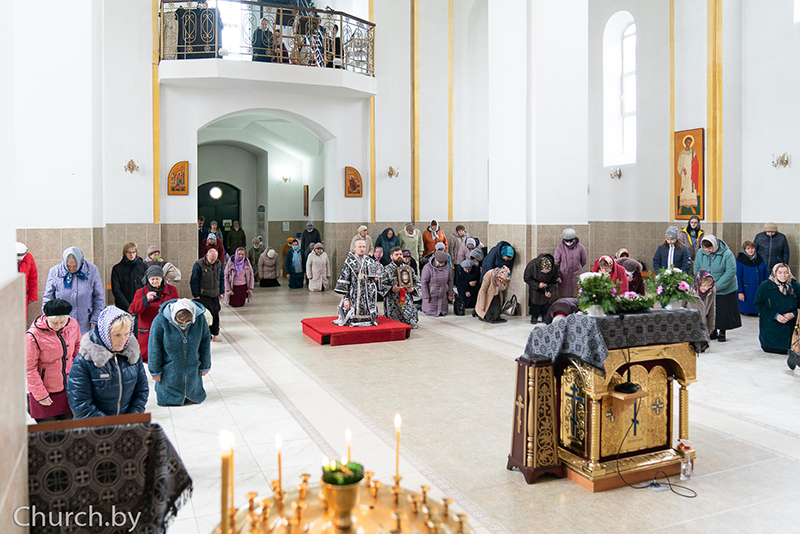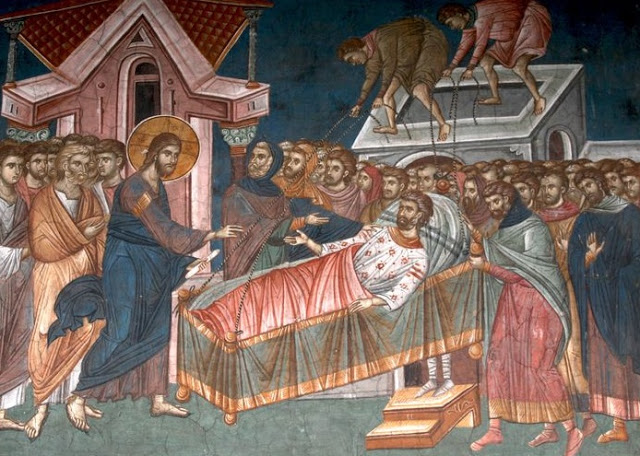
Our Lenten journey continues, but the liturgical life of many Orthodox Christians is back to the usual routine. The reading of the Great Penitent Canon is over, the Sunday liturgies all sound familiar, while coming to church during the week is burdensome for most.
Still, despite the busy weeks, many parishioners are interested in attending the Liturgy of Presanctified Gifts at least once in the Lenten season and taking communion. A worship service seems to come alive to anyone who has at least some idea about it. This applies to the order of the service, but also its history and meaning. With this in mind, let me discuss – at least in very general terms – the Liturgy of Presanctified Gifts, a rare and unique service in church life.
What makes it distinct from all others is the absence of the anaphora, the main part of a liturgy in which the miracle takes place of the transformation of bread and wine into the Body and Blood of Christ. Nevertheless, it keeps the other attributes of communal worship, such as joint prayer, breaking of the bread and the Eucharist.
Interestingly, the liturgy of Presanctified gifts has been preserved only in the Eastern churches and in the Orthodox and Malankara Churches of India. The Catholic churches and select Anglican parishes only celebrate the Good Friday Communion, sometimes called the Mass of the Presanctified.
A worship service seems to come alive to anyone who has at least some idea about it.
The tradition of communing the faithful with Presanctified gifts has its roots in the pre-apostolic times. Bishop Simeon of Thessaloniki writes: «The Liturgy of the Presanctified has come to us from the successors of the Apostles, and we fully believe that we have inherited it from the Apostles.
Yet its earliest mention dates back to the early seventh century. The Paschal Chronicle of Constantinople (615) reads: “Starting from the first week of the Great Lent of 615 during the reign of Patriarch Sergius of Constantinople, the following hymn was chanted after the words “May it come to pass” at the delivery of the Presanctified gifts to the altar with the chant “By the gift of Christ”^ – “Now the celestial powers…” Such hymn shall be chanted during the Great Lent and on all other days when the service of Presanctified Gifts is celebrated».
Patriarch Sergius mentioned in the document turned out to be a heretic who supported the spread of the false teachings of Monothelitism. However, the tradition instituted by Rule 52 of the Sixth Ecumenical Council, is described as follows: «The present Canon commands that on the other days of Lent there shall be a celebration of the liturgy of the Presanctified, except on Saturdays and Sundays.».
Zonaria, Valsamon and other commentators also take note of several elements of meaning in the liturgy. They write that the offering of a sacrifice to God is a celebration, and as such, it is an expression of joy. But the Great Lent is a time of penance, mourning and contrition, and therefore a pre-sanctified offering is in order.
The Constantinople rite of the Liturgy of the Presanctified has entered the Russian liturgical tradition and has been practised to this day, with some variations.
Also of interest is this narrative recorded by the Greek hagiographer Anthony Chosebite. A novice of a Palestinian monastery brought with him the phosphora. On his way, he had read a portion of the Anaphora prayer that he had heard in a church, whereupon the Holy Spirit descended on the bread. Afterwards, an angel appeared to the Hegumen of the monastery in a vision and instructed him not to perform the blessing of the gifts, as they had already been sanctified.
The offering of a sacrifice to God is a celebration, an expression of joy. But the Great Lent is a time of penance, mourning and contrition, and therefore a pre-sanctified offering is in order.
In addition to this narrative of Anthony Chosebite, also worth mentioning is the Liturgy of Presanctified Gifts of Apostle James, present in the Palestinian tradition up until the 12th, and possibly the 14th century (not to be confused with the full liturgy of Apostle James. Similar to the other rites, its central element was also the solemn entrance with the Holy Gifts to the hymn “Now the celestial powers.”
Also practised in church life was the Egyptian rite It originates from the Coptic church. Although it has not survived to our time, its description is available in a Greek manuscript. It contains the title of the thanksgiving prayer following the Communion from the Liturgy of the Presanctified of Apostle Mark and the full text of the prayer “Forty Days of the Holy Lent” identical to the prayer over the Arthos of the Constantinople rite.
The Egyptian liturgical tradition was closely connected with that of Nubia. One of the surviving Nubian prayers over bread and wine contains the following supplication: “|Let the power of Your Holy Spirit descend into this cup and be transformed by means of this pre-sanctified part”, also referring to the Presanctified gifts and their transformation into the Blood and Body of Christ.
In the tradition of the Latin West, the Mass of the Presanctified is celebrated on the Great Friday. We should not see it as a separate office, as it was never a required rite and was always seen as an addition to the ninth hour.
This begs the question: If Western Christianity does not have a separate rite of the Liturgy of Presanctified Gifts, why, then is the authorship of the Constantinople rite attributed to Pope Gregory the Dialogist? The troparia after the thanksgiving prayers are addressed to him.
Up until the 12th century, the title of the liturgy of Presanctified gifts contained no indication of the author, but references to German of Constantinople and Epiphanius of Cyprus appeared in later years. In the 15th and 16th centuries, the names of Saint Gregory the Theologian, Basil the Great and Gregory the Dialogist were added.
There are several possible explanations for the attribution of the Liturgy of the Presanctified to Gregory the Dialogist. According to the most plausible of them, the Synaxarion of the Constantinople Church contained a description of his life under 12 March. Specifically, the text of his life credits him with the introduction in the Latin West of the celebration of the full liturgy on weekdays during the Great Lent. – Incidentally, unlike the Russian church, the Greek church has no tradition of mentioning his name at the closing of the liturgy.
In conclusion, let us underline that in the past, the Lenten Liturgy of the Presanctified was not celebrated only on weekdays. From the 9th to 11th centuries, the Church Typicon of Constantinople also allowed the liturgy to be served on Wednesdays and Fridays of the Cheesefare Week, the Holy Friday, and also on Wednesdays and Fridays throughout the rest of the year.
Translated by The Catalogue of Good Deeds
Source: https://spzh.news/ru/chelovek-i-cerkovy/78415-pochemu-konstantinopolyskij-chin-ozaglavili-imenem-rimskogo-jepiskopa




